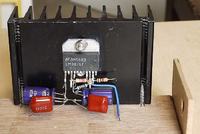goldsmith
Advanced Member level 6

- Joined
- Dec 14, 2010
- Messages
- 3,981
- Helped
- 741
- Reputation
- 1,486
- Reaction score
- 726
- Trophy points
- 1,413
- Location
- Tehran - IRAN
- Activity points
- 24,546
Hi again hshah
I don't know why you used that capacitor in parallel with BE junctions ( it seems unnecessary ) . the out put stage is a simple complementary stage at class AB . isn't it ? and there is an op amp , to drive them . with this arrangement you can use cheaper opamps ( usual opamps ) . and i think perhaps you know how that feedback loop in that opamp does work ? and i suppose that you know how a freewheeling diode does work too ?
Best Wishes
Goldsmith
I don't know why you used that capacitor in parallel with BE junctions ( it seems unnecessary ) . the out put stage is a simple complementary stage at class AB . isn't it ? and there is an op amp , to drive them . with this arrangement you can use cheaper opamps ( usual opamps ) . and i think perhaps you know how that feedback loop in that opamp does work ? and i suppose that you know how a freewheeling diode does work too ?
Best Wishes
Goldsmith




